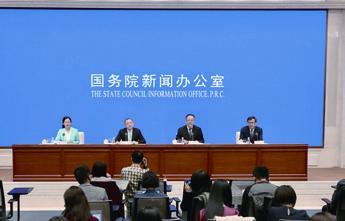Targeted Credit Support Bolsters Growth of Real Economy
2019-11-05

China reported faster-than-expected growth in total social financing and continued decline in off-balance-sheet credit, which showed progress in government efforts to tame financial risks while maintaining growth.
The latest data released by the Peoples Bank of China (PBC), the central bank, showed that newly added social fi nancing, a measurement of funds that individuals and non-financial firms get from the financial system, rose 138.3 billion yuan ($19.52 billion) from a year earlier to 2.27 trillion yuan($321 billion) in September, beating analystsforecasts.
Within the social financing measure, outstanding non-standardized assets, including trust loans, entrusted loans and bankers acceptance bills, or those often considered as shadow banking activities, declined 113 billion yuan ($15.96 billion) month on month in September, investment bank China International Capital Corp. (CICC) noted.
The divergence in credit data came as regulators seek to channel funds into sectors where loans are most needed, while fending off risks rising from banks off-balance-sheet financing as well as high leverage in the property sector.
Faced with external uncertainties and a slowdown in economic growth, the country has been stepping up monetary support, especially to cash-strained small and private enterprises, with a variety of tailored measures.
On October 15, the central bank reduced the cash that lenders must hold as reserves for some city commercial banks, the first phase of a targeted reserve requirement ratio (RRR) cut that is expected to unleash a total of 100 billion yuan ($14.12 billion) into the market.
The move followed a broad-based RRR reduction in September as well as a lower one-year loan prime rate (LPR), the new benchmark interest rate for new loan issuance since the country revamped the LPR mechanism in August.
“September money supply and total social financing data indicated that some of the short-term growth stabilization measures may be at work,” said CICC in a research report.
Ruan Jianhong, head of the PBCs Statistics and Analysis Department, said the forecast-beating credit data in September was a combined result of robust financing demand as well as enhanced effectiveness for monetary authorities to channel funds into the real economy.
Central bank data showed that growth in outstanding medium- to long-term loans to the infrastructure sector as well as to the hitech manufacturing sector picked up pace in September, while that to the service sector, excluding the real estate industry, also registered rapid growth.
“This round of policy stimulus is rather restrained, with a tight grip on funds flowing into the property sector,” said China Merchant Securities in a research note.
Growth in the outstanding loans to the property sector slowed for a 14th straight month to 15.6 percent at the end of September, while newly added mortgage loans accounted for 24.1 percent of loans of all kinds in the fi rst three quarters, lower than 30 percent in the past several years, according to Zhou Xuedong, another PBC offi cial.
While the one-year LPR was lowered in September to support short-term lending, the above-five-year LPR, an anchor for mortgage lending, remained unchanged at 4.85 percent, another sign that authorities are determined to rein in speculation in the property sector, analysts said.
